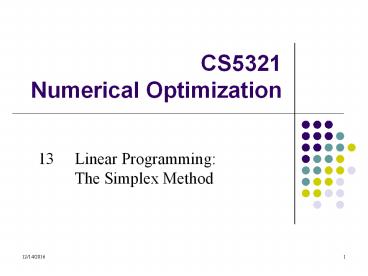CS5321 Numerical Optimization - PowerPoint PPT Presentation
Title: CS5321 Numerical Optimization
1
CS5321 Numerical Optimization
- 13 Linear Programming The Simplex Method
2
The standard form
- The standard form of linear programming is
- MinxzcTx subject to Ax b, x ? 0
- Matrix A is an?m?n matrix, where m is the number
of constraints and n is the number of variables.
- We assume A has full row rank and m ? n.
- For Ax?b, add slack variables. Ax - s b, s ? 0.
- For Ax?b, subtract slack variables Ax sb, s ?
0.
3
Geometry of LP
- Feasible region ? the set of all feasible points
- If ? is empty, LP has no solution. (infeasible)
- If ? is nonempty, it is convex.
- If the object function is unbounded on ?, LP has
no solution. - If LP is bounded and feasible, it can have
either one or infinitely many solutions.
4
Basic feasible point
- A point x is a basic feasible point (or a vertex
of feasible polytope) if it is feasible and is
not a linear combination of any other feasible
points. - If LP has solutions, at least one solution is a
basic feasible point. (Theorem 13.2) - At a basic feasible point, at least n-m
variables are zero. - The case it has more than n-m zero variables is
called degenerate.
5
Basic variable and basis matrix
- At a basic feasible point, variables that can be
uniquely determined are called basic variables. - The other are called nonbasic variables. (set to
zero.) - Let B, N be the index sets for basic/nonbasic
variables. - Variable x, c, and A can be rearranged according
to basic/nonbasic variables. - B, an n?n nonsingular matrix, is called the basis
matrix
6
Simplex multiplier
- Since xN0 at a basic feasible point
- Object function
- Constraints
- The basic variables are and therefore the
object function - The simplex multiplier is
7
Pricing
- Object function
could be decreased by changing nonbasic
variables, xN. - ,
- Plug in ,
- The vector is called pricing.
- If sN(i)lt0, z can be decrease by increasing
xN(i). - If all sN(i)?0, the optimal solution is founded.
8
The ratio test
- Select q s.t. sN(q)lt0 is the smallest element in
sN and increase xN(q) until one element in xB,
say xB(p), becomes zero. (How to find p?) - Need xB(i) ? 0 for all i. If B-1N(,q)(i)lt0,
then xB(i)gt0 - Only need to consider i for B-1N(,q)(i)?0
- What if no such i? the unbounded case
9
Pivoting
- Exchange p and q in B,N and update xB, xN and B.
- Let
- Update xB xB- ?d and xN(q) ?
- Update B replace B(p) with N(q) (How about B-1?)
- It is a rank-1 update. Let B be the updated
one. - The Sherman-Morrison formula
10
The simplex method
- While (true)
- Given B,N. xBB-1b, xN 0 (Basic feasible
point) - ?B-1cB, sNcN-NT? (Simplex multiplier, pricing)
- If sN ? 0, stop (Found an optimal solution)
- Select q s.t. sN(q)lt0, and solve BdN(,q)
- If d ? 0, stop (Unbounded case)
- Compute ?,pmind(i)gt0 xB(i)/d(i) (Ratio test)
- Update xBxB- ?d and xN(p) ? (Pivoting)
- Exchange p and q in B,N and update matrix B.
11
Remaining problems
- How to find the initial basic feasible point?
- Two phase algorithm add more slack variables to
make the trivial point (0,,0) feasible, and
solve it until all additional slack variables
become zero. - How to resolve the degenerate case?
- In degenerate case, the algorithm might pivot the
same p and q repeatedly. - Perturb the constraints to avoid the degenerate
case.
12
Complexity
- In each iteration, the most time consuming task
is pricing, ratio test and update B. O(mn) - The number of iterations is less than or equals
to the number of basic feasible points, which is - The worst case time complexity is exponential.
- Try n2m. The number of iterations gt 2m.
- But practically, it terminates in m to 3m
iterations. - Average case analysis and smoothed analysis.

